Traditional Iranian Food of ancient Persia
For most people, one of the most enjoyable parts of traveling to a new city or country is trying the traditional and local food of that place. On this matter, Iran is an amazing choice for people who enjoy trying out different cuisines. The cooking skills of Persian chefs and the taste of traditional Persian food have always been famous all over the world. In addition to traditional Persian food that is cooked in every corner of the country, most cities and villages have their own specific food. For this reason, there are various ingredients for preparing Persian dishes.
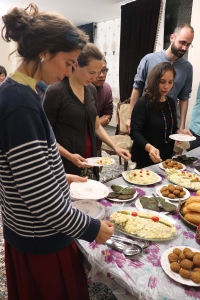
Eating dinner at NarciBnB during Persian Night event
Persian Eating Habits & Customs from Ancient Times
In the past, for the aristocrats, large bowls of Polo (Rice dishes) and Kebabs were prepared for only two to three people. People ate their food mostly by hand. That being said, the use of spoons and forks was less common. A variety of drinks were served with meals in large pitchers. There were no handkerchiefs on Iranian tables. However, there was always copper or silverware that they used for washing their hands before eating. These specific wares were called Aftabeh and Lagan. The aristocrats always had servants by the table.
Ordinary people mostly prepared rice with a variety of Khoresht (stew) for themselves. They always ate together. Breakfast and lunch were the two main meals for the day. These customs persisted even after the Safavid Dynasty and until the Qajar era. But how about today? Are people still following the eating habits and customs of the past?
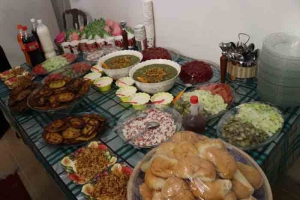
Persian homecooked fast foods
History of Persian Cuisine
From prehistoric times to the earliest records of history, the vast area of the Iranian Plateau is where a specific food culture took shape. In other words, Persian food culture is one of the earliest traditions in the world. Due to its geographical diversity, from the south to the north and east to the west, the traditions differ. However, the history and culture of Persian cuisine persist in all parts and regions of Iran. There is not much information about the pre-Islamic times about the Persian food culture. Most of the traditions that are carried out today are from after the advent of Islam. That being said, it all started from the Safavid Dynasty around 400 years ago. Letters and manuscripts left by Safavid chefs are one of the main sources of information on Iranian food. The writings of Safavid court chefs depict a very luxurious and aristocratic style of cooking and serving food in Iran. Safavid travelogues also provide very useful information about Persian eating habits and customs
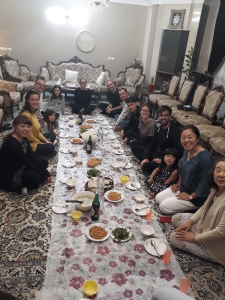
Gathering around Sofreh on the floor during Persian meals
Pre-Islamic Persian Food Culture
There is almost nothing left of the pre-Islamic Persian food culture, and in the cases that have survived, it is more about the food culture related to the aristocracy and princes. Perhaps one of the best examples of documents left that can represent Persian cuisine is the Arjan Bronze Cup. These types of objects usually depict the food culture and clothing styles of different eras.
Post-Islamic Persian Food Culture
After the decline of the Sassanid dynasty, the Arabs became more acquainted with the lifestyle of the Persians during the Sassanid era. The presence of Persian courtiers in the palace of the Abbasid Caliphs also had its influence in helping this matter. Persian food also influenced the three Seljuk, Ilkhanid, and Mongol dynasties that ruled Iran from the 13th century. In addition, there is ample evidence that foreigners invading Iran also influenced Persian food. For example, cranberry, which is a type of black curd or flour, was used by the Turks. Over time, it became one of the ingredients of some Persian dishes, especially in central Asia.
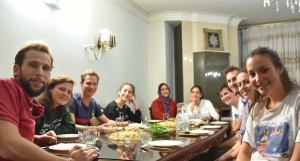
Dinner at NarcisBnB in Isfahan
Safavid Era Persian Food Customs
What we know about the Persian food culture, mostly comes from the Safavid era. Letters and manuscripts written by chefs and some travelogues are one of the main sources for research on Persian food. The writings by the court chefs show a very luxurious and aristocratic style of cooking and serving food in Iran.
A variety of dishes such as Polow, Koko, Ash, Dolma, and Kofta were among the popular court dishes in ancient Persia. Safavid travelogues also provide very useful information about Persian eating habits and customs. For example, according to these documents, we know that:
- In the past, large bowls of Polow and kebabs were prepared for two or three people, and Persians always ate together.
- People mostly used their hands to eat food, and the use of spoons and forks was less common.
- A variety of drinks were served by pitchers, and the drinks were mixed with large wooden spoons.
- There were no handkerchiefs used by Persians while sitting beside the table, instead people washed their hands in copper or silver bowls called Aftabeh Lagan brought by their servants before eating.
Common people in Iran ate much simpler food, for example, a variety of Polows and Stews. Eating a light breakfast and rich lunch was common among Iranians.
During the Qajar era, the richness of Persian dishes was evident to the travelers and this fact is found in many old travelogues. During this era, food was arranged and served in beautiful dishes (set on a tablecloth on the floor) and the food of aristocrats was very different from common people.
Persian food culture is known for rice dishes or dishes paired with rice and also the overall long process of cooking.
Rice is the main ingredient in Persian food and the rice used by Persians in ancient times mostly came from the northern provinces of Iran. In many travelogues from the Safavid and Qajar eras, it is mentioned that Polow is the national and main food of Iran and Persians must have Polow on their tables at every meal. Jacob Edward Pollack, a world traveler, writes in his writings that Polow, Chelow, and Ash are the three main dishes in Iran, all three of which are made from rice.
Persians eat Polow with stew and they pair it with a variety of drinks and side vegetables.
Persian cuisine has a very calm and slow style of cooking and all the ingredients in Persian cuisine must be thoroughly cooked. Even fried food is fried over a gentle, steady heat for a long time. The taste of Persian food is not spicy at all and it is very mild in terms of taste compared to food around the world, and although all kinds of spices are used in Persian dishes, but all the effort and art of the chef is to balance the spices. On the contrary, Persian side dishes are rich in flavor. Pairing various side dishes like pickles, drinks, and vegetables with the main dish can be a great experience for people who are interested in food tourism.
With a long history, one of the main parts of Persian culture is its cuisine. Persian cuisine varies from region to region due to the vast difference in local ingredients, climate, culture, and history of Iran. The food of each part of the country represents its cooking style, regional flavors, and dining customs. In this post, we will be talking about the most famous Persian dishes in famous regions of Iran. Also, we will dive into the history of Persian cuisine and customs in the past and the present.

Traditional Persian Meals
Persian Cooking & Eating Habits Today
Persian cuisine is most famous for its method of slow cooking. And more than that it is famous for the excessive use of rice. Almost every Persian food and dish accompany a rice dish. In many Safavid and Qajar travelogues, Polo (mixture of rice with other ingredients) is mentioned as the national and main food of Persians. In the travelogues of Jacob Edward Pollack, he mentions that the three main dishes of Iranians are Polo, Chelo, and Ash. All three of dishes these dishes are made with rice.
Today, Iranians just like the ancient times, pare rice with different stews and various drinks and side dishes. All Iranian food must be completely cooked. As we mentioned before, the slow cooking method is one of the main characteristics of Persian food. That said, even the fried food is cooked over a low flame for a long time. The flavors used in the cooking of different Persian dishes are a whole world by themselves. Persian chefs use a variety of spices and herbs in their food. However, the flavors end up not strong but always harmonious. It is worth mentioning that each city and each region in Iran uses a different mixture of spices. For example, the southern part of Iran is famous for its spicy food.
Regarding the eating habits of Iranians, today, families still gather for every meal together. Breakfast and lunch are still the two main meals for Iranian families. Aside from the main dishes, preparing side dishes is also very common. These side dishes range from freshly picked vegetables to yogurt, drinks, and pickles. However, with all that being said, still, each corner of Iran has its own specialties in cooking styles, dining habits, and main dishes.

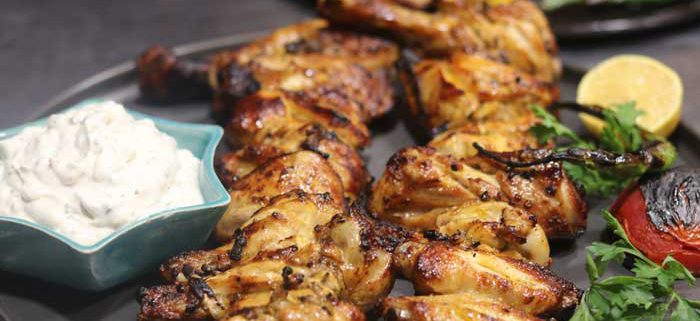

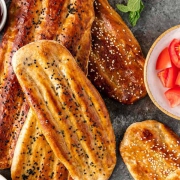
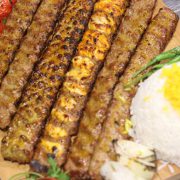

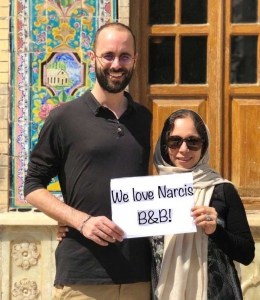




Leave a Reply
Want to join the discussion?Feel free to contribute!